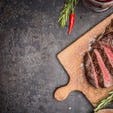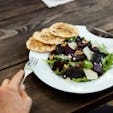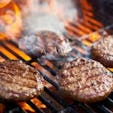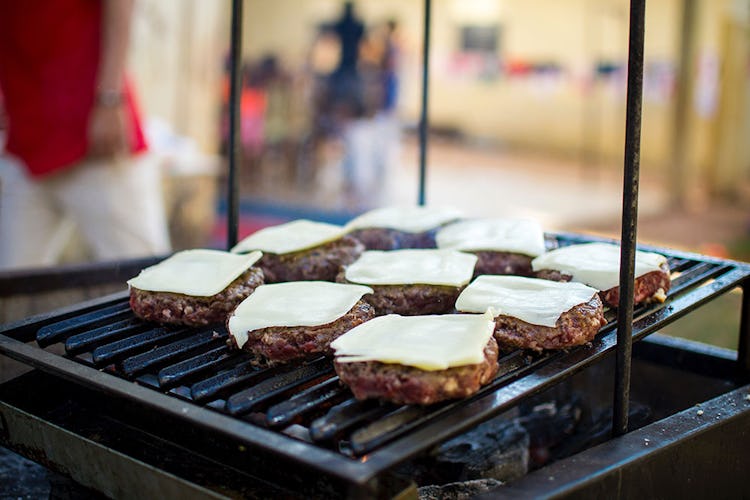
Your friends call you “Captain Caveman,” “Geico™,” or “Paleo Pete.” You’ve cut dairy, grains, legumes, and all processed foods from your diet, and instead embrace local, organic produce and grass-fed beef. You snack on nuts and pass on starches, and the fish you eat all but leap into your skillet from a nearby stream.
In short, you’ve “gone Paleo.” You’ve committed to the Paleo Diet™, or some similar approach to caveman-style eating where you hardly ingest anything that wasn’t available to humans two million years ago. (Or, maybe you’re just curious about caveman diets and are wondering if they’re something you could do, in which case, see our guide HERE, first).
The Paleo Guide to Restaurants, Fast Food, and Takeout
Cutting all kinds of allergenic and inflammatory foods out of your diet will usually leave you looking great and feeling even better… there’s just one problem: You may feel like a prisoner in your own kitchen.
Strict caveman eating requires that you prepare most of your meals yourself, to ensure that your food is of the highest quality and no forbidden ingredients sneak in. Going out to a restaurant, or hitting a drive-through window when you’re short on time, is a big gamble, but you’re living in modern times, and you know that a hectic schedule and (hopefully) an active social life is bound to lead you to temptation now and then.
In those moments, you could be swept into a gastronomic time warp that sends your body screaming back to the 21st century—potentially in a vortex of processed grains and sugar. But for all the temptations and nutritional abortions that modern living poses, there are nearly as many ways to get your meal the way you want it virtually anywhere you eat. Here’s your guide to staying (mostly) Paleo when it seems like you can’t.
Challenges of Eating Out On A Paleo Diet
Paleo basics aren’t hard to understand. Eat the meat, skip the potatoes; eat the veggies, skip dessert. But there are variations to the way caveman dieters eat, and you’ll have the best chance of staying true to your version of the diet when you’re eating out if you clearly define what you want it to be first.
Hardcore Paleo dieters avoid literally anything that couldn’t be hunted or gathered during the Paleolithic Era. They will have the most trouble sticking to the program while on the road or out on the town. The classic Paleo Diet™ doesn’t even allow salt, which most restaurants include in the cooking process, so if this is a point of contention for you, make sure to specify to your server beforehand that you want your meal sans flavor—er, salt. Farm-to-table restaurants may be your only refuge, unless you’re willing to limit yourself to only the most basic roadside pitstop foods such as hardboiled eggs, raw, unsalted nuts, whole fruit, and pre-packaged salads (hold the dressing).
If you’re the kind of caveman/woman who bends the rules and eats tubers (such as sweet potatoes) and/or dairy, your options open up much more. But you’ll still have to look closely at menus and ask questions to see that the cook isn’t sneaking forbidden foods into your meals, and, unfortunately, research shows that the nutrition info on restaurant menus tends to be highly inaccurate.

According to two recent studies, the nutrition numbers many chain restaurants make available on their menus contain more understatements than an Al Capone tax return. Research from 2011 found that one in five chain-restaurant products contained at least 100 more calories per serving than was listed; one in 10 averaged nearly 300 more. Meanwhile, a 2010 study found that even reduced-calorie entrees in chain restaurants were usually understated as well—sometimes by nearly 20%. That doesn’t automatically disqualify these items from being Paleo, but in most cases, it’s a safe bet that the majority of those calories are coming from foods that aren’t caveman-friendly—butter, processed vegetable oils, and sugar.
One of the biggest criticisms of Paleo eating in general is how expensive it can be, as grass-fed meats and organic produce always run a few dollars more than their conventional counterparts. Eating out is no exception. It can be difficult to find restaurants that serve organic food in the first place, and when you do, prepare to pay a little more. Burger Lounge™, a chain popular throughout California, offers an amazing Paleo Burger, featuring grass-fed beef, nitrate-free bacon, and a heap of vegetables—but you’ll pay $12 for it (a good-sized half-pound patty). Bareburger™, another Paleo-friendly franchise, offers similar hookups nationwide and internationally, but at similarly steep prices.
What To Avoid Eating At Restaurants On Paleo
If you’re eating like a caveman, you can’t have the following (with some exceptions).
Butter
Some cavepeople consider butter—particularly organic butter from grass-fed cows—a legit exception to the no-dairy rule. But if you’re strict Paleo, you’ll have to make frequent requests that your servers hold the butter and any other milk products, as these are staples in many types of cuisine. Dairy products in general show up in the darnedest places, such as the crispy Brussels sprouts and six-ounce sirloin at T.G.I. Fridays™ (according to their allergen menu HERE), for example. Same goes for the house salad and herb-grilled salmon at Olive Garden™. As Paleo as an item may seem, make sure you research it before you order.
Processed vegetable oils

Inflammation-promoting hydrogenated oils are fortunately becoming scarce at restaurants as the food- service industry bows to tougher regulations. But most chains still use many of the vegetable oils Paleo dieters try to avoid. Just about everything you could order at McDonald’s™—from the burgers to the salads—contains canola, corn, and soybean oil (see their nutrition calculator HERE). The asiago chicken sandwich at Wendy’s™—which looks pretty Paleo if you leave the bun and condiments off—does too.
Sugar
Until archeologists discover cave paintings of high-fructose corn syrup, refined sugar will remain firmly in the “hell no” column for Paleo dieters. But sugar, and other ingredients ending in “ose” (always a tell for the sweet, white stuff) proliferate in nearly all chain eateries. With its veggies, seeds, and fruit, the Apple Harvest Chicken Salad at Quiznos™ appears to be almost perfectly Paleo, and yet it packs 29 grams of sugar (more sugar in one meal than what the World Health Organization recommends you should consume in a day, regardless of which diet you follow).
Gluten
Wheat is hard to escape too. Of course it’s in hamburger buns and baguettes, but it can also end up in your eggs, and it does in IHOP’s™ omelettes. Wheat flour is cheap and adds flavor, so many restaurants just toss it into their recipes. Unless you have celiac disease, small amounts of wheat aren’t dangerous—but they aren’t Paleo, either. And if you hit fast-food joints or takeout regularly, these small amounts add up.
While staying 100% Paleo is admirable and manageable with a lot of planning and foresight, many experts suggest you bend the rules when you eat out—for the sake of your own sanity. “When they go out, I try to get my clients to stick to a plan that’s 80% Paleo, 15% minimally-processed foods, and five percent off-plan foods,” says lifestyle coach and exercise physiologist Dr. Mark J. Smith (docsmith.org). That’s doable just about anywhere, he says. “Nearly every restaurant will grill you some animal protein and sautée some veggies if you ask.” The meat may not be organic, and the oil might be non-Paleo—but other than that, you’re doing pretty well. Following this advice, you certainly won’t take in the massive amounts of calories or sugar that are sure to put weight on you and damage your health.
Before you hit a restaurant, says Smith, “Decide whether you’re going to more or less stick to your plan or just go for it and have fun with your friends.” As long as you don’t make a habit of throwing your meal plan out in favor of French Fries and ice cream, either choice is fine. “At the end of the day,” says Smith, “You have to live.” And it’s what you do and eat consistently—not one night a week—that determines how you look and feel.
If you want to be absolutely sure that what you’re eating is Paleo all the way, order a plain salad with some meat or fish on top, nuts, and olive oil. If you’re willing to risk a few not-quite-caveman ingredients, the options below will open up a world of flavor for you (not to mention convenience), even though they might still contain small amounts of salt, wheat, butter, or vegetable oils.
What Can I Eat at a Mexican Restaurant?
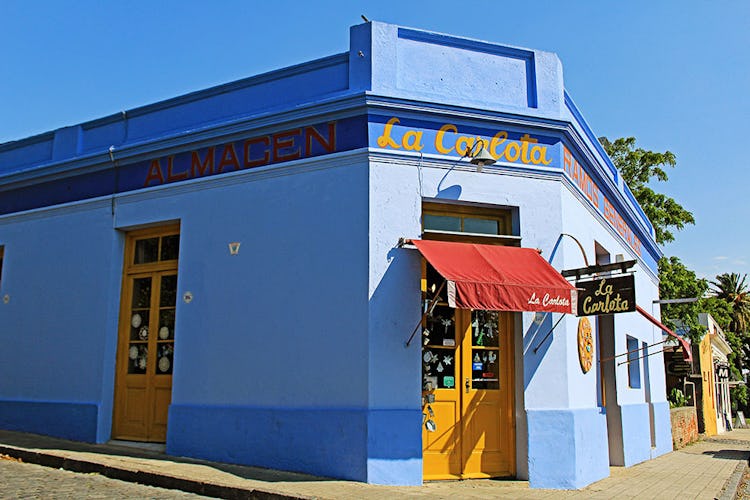
Oh dear. What can you order at a place where the staples are beans, tortillas, and cheese? The good news: many Mexican dishes feature separated rather than mixed ingredients. If you order fajitas, they bring a plate of meat and veggies and separate dishes with the tortillas and toppings, so it’s easy to filter out what you don’t need—or ask them to hold it.
Fajitas with chicken or beef are a good choice. Ask them to leave out the tortillas, beans, and rice (or give them to a hungry fellow diner). As for sides, forgo the sour cream (dairy), and ask for double guac, which is loaded with healthy fats and totally Paleo. Ceviche is great if you’re down for raw fish, and carnitas (pork shoulder) is a classic—on a salad rather than in a taco, naturally. Carne asada should be OK in theory, as it’s just steak, but it’s often made with soy sauce, which contains wheat, just so you know.
What Can I Eat at a Japanese Restaurant?
Japanese cuisine rarely includes much dairy or wheat (score!), but always offers soy, rice, and rice noodles in abundance (boo!). Sugar in various forms also frequently lurks in the sauces and sides.
Go with sushi rolls without rice, or sashimi—raw fish on its own. Enjoy the wasabi, but don’t go crazy on the ginger (it’s candied). Grilled eel or other fish are good, as is shabu shabu—meats and vegetables that you cook yourself at the table in a hot broth. Some Japanese restaurants now offer coconut aminos on request—a salty-sweet soy sauce alternative you can use for extra flavor. As for veggies, edamame (soybeans) are out, but seaweed salad is right on the money.
What Can I Eat at a Chinese Restaurant?

You’d think that one of the world’s oldest civilizations would have Paleo down pat, but Chinese food is surprisingly tough to navigate: soy, rice, cornstarch, sugar, and other forbidden delights lurk in almost every entrée. Moo Goo Gai Pan—chicken and veggies, more or less—is a safe bet, as is beef or ginger chicken with broccoli (order gluten-free if that’s an option, as sometimes flour is added to the pan to thicken the sauce). Of course, hold the rice that comes along with it. Egg drop soup will have corn starch, but if you can stomach that, it’s not a bad option (without added tofu, that is).
If you’re eating at a truly authentic Chinese restaurant—aka not P.F. Chang’s™—you’ll do much better. Hot pots with meat and veggies, bok choy, steamed fish, cumin lamb, and saltwater duck should all be Paleo, or pretty damn close.
What Can I Eat at an Italian Restaurant?
The American way of eating Italian—open mouth, insert pasta and pizza till comatose—is about the farthest thing from Paleo imaginable. But you’ll rarely see a meal like that in Italy. Real, authentic Italian food—that is, not Domino’s™ or Olive Garden™—features fresh produce, high-quality meat, poultry, and seafood, and copious use of olive oil, all of which are perfectly Paleo. That makes an Italian restaurant a decent choice for the modern caveman, assuming you steer clear of the pasta.
Try to order an entrée salad. Many Italian restaurants have a meat-and-greens option on the menu. If not, special-order a salad with a serving of grilled meat, chicken, or seafood, topped with vinaigrette dressing. No croutons, cheese, or other creamy or bready toppings.
An excellent compromise, if you’re craving something with a traditional Italian feel, is to order a pasta dish like pesto or Bolognese, but substitute lettuce, raw spinach, zucchini pasta, or other greens for the noodles. It’s the Italian-restaurant equivalent of the lettuce-wrapped burger.
What Can I Eat at an Indian Restaurant?

The yogurt and creamy curries at Indian restaurants are an ethnic-epicure’s dream, but a Paleo dieter’s nightmare. Look for “masala” or “vindaloo” dishes—they’re tomato-based rather than cream-based—and avoid naan bread, Korma, biryani, and Tikki Masala. Ghee—clarified butter—is made from butter but is usually considered Paleo since the milk solids are removed. When ordering anything Indian, it doesn’t hurt to ask the waiter about your entrée—Indian chefs love to sneak dairy in where they can.
What To Eat At Olive Garden™ on Paleo
We won’t ask what you’re doing in a place that offers free, unlimited breadsticks. (Your friends dragged you there, kicking and screaming, of course.) But should you happen to end up at the place that treats you like family, you’ll have to err on the side of grilled animal protein and veggies, says Trevor Connor, a nutritionist and performance coach (thepaleodiet.com). “Some people think being ‘that guy’—the finicky one who’s always ordering off menu—is a stigma, but I think it’s a valiant stigma,” he says.
Don’t want to make a scene? Go for the Taste of the Mediterranean menu and order the Herb-Grilled Salmon, Chicken Piccata, or Salmon Piccata. They’re all high in sodium, but are otherwise caveman appropriate, and you get more than 40g protein with just 20g of carbohydrate.
What To Eat At Buffalo Wild Wings™ on Paleo

Top choices at this heart-attack haven are the “protein options:” a grilled chicken breast or an all-beef hamburger patty. Add all the healthy fixings—lettuce, tomato, and red onion, and, except for having to watch all your friends down plates of Buffalo Loaded Tots covered in BBQ Pumpkin Ale Sauce, you’re good to go.
If you can’t help yourself and want to get in on the chicken wing-action without going hog wild, you can get your wings grilled for you if you ask. Opt for the dry seasonings—Desert Heat is great—and go easy on the high-sodium signature sauces.
What To Eat At Taco Bell™ on Paleo
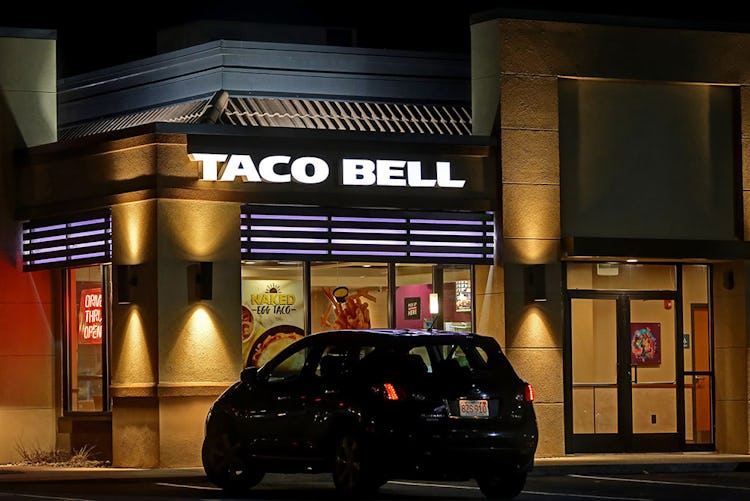
Look to their Power Menu, which is, essentially, burritos and tacos without the tortillas or shells. The Power Menu Bowl with fire-grilled chicken, pico, guac, and romaine is 140 calories, 17g protein, and 4g carbs. Order the same meal with beef and you’re looking at 220 calories, 11g protein, and 9g carbs. The non-Paleo avocado ranch dressing adds a ton of flavor, but just a gram of carbs to either selection. Check out their user-friendly nutrition calculator.
What To Eat At McDonald’s™ on Paleo
Here it is: the granddaddy of all fast food. This may be the place to throw it all out and go for it. “If you’re going to hang yourself,” says Connor, “don’t skimp on the rope.”
To be fair, the golden arches are making a serious effort of late to offer better quality goods. Their site even has a nifty nutrition calculator that allows you to customize your order, adding or subtracting ingredients to see exactly how many carbs are in the tortilla strips on your chicken salad, say, or how many calories are in the cheese.
Your best bet: order up an Artisan Grilled Chicken fillet, hold the bun and the herb vinaigrette sauce, and you’ll have yourself a decent 140-calorie snack with 29g of protein and just 2g of carbs.
Or you could go for a Southwest Grilled Chicken Salad, hold the tortilla strips, corn, beans, and cheese for a heartier 210-calorie meal with 30g of protein and just 13g of carbs. Or… what the hell, grab both of them: that’s 350 calories and about 60g of protein—more than enough to tide you over till you get to the next rest stop.
What’s The Best Paleo-Friendly Fast Food?
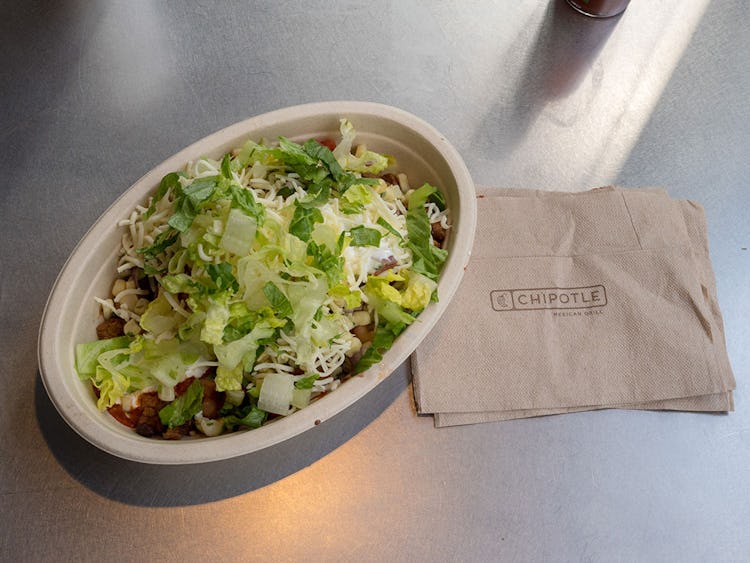
Drumroll… And we gotta go with Chipotle™. But let’s be clear: even if you order well, eating at Chipotle™ is decidedly not Paleo. The meat isn’t organic, it’s loaded with salt, and they use vegetable oils to prep most items, but other than that, Connor says this is a good spot to hit in a pinch, and probably the most Paleo-friendly of the big chains. You get to handpick from simple ingredients—so avoid the dairy, the tortillas, and the beans.
Salad bowls with lettuce and pico de gallo are great—but watch out for the vinaigrette (it has bran oil). Or just go with a custom bowl of double-meat and double guac, which is fast, delicious, and (virtually) guilt-free.

)
